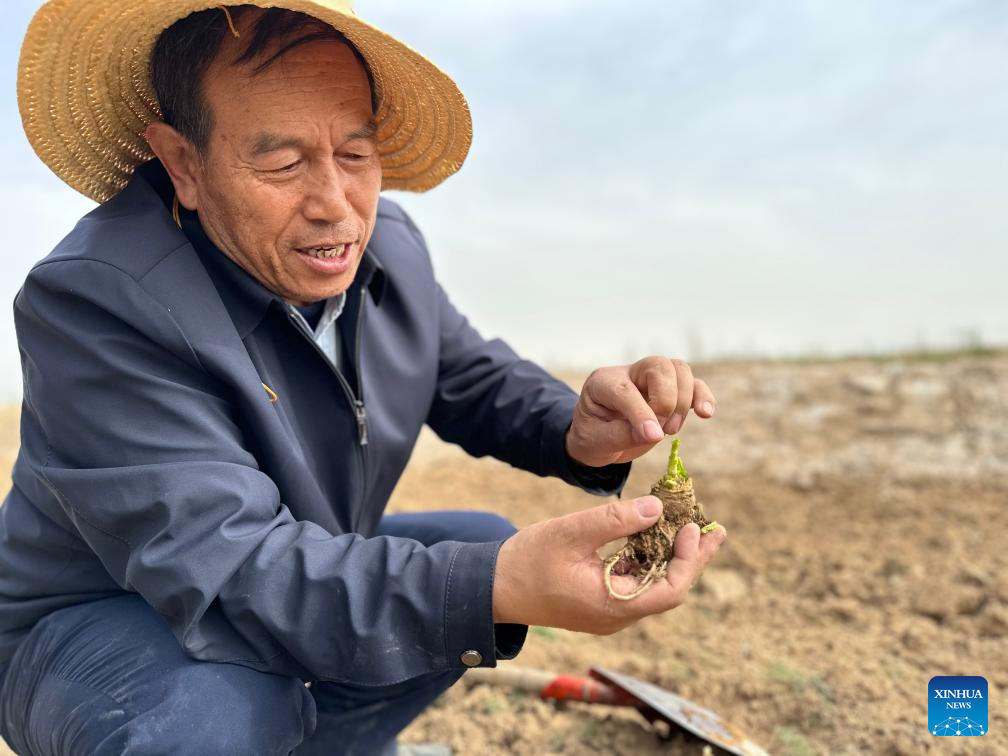
Sun Wancang (C) and colleagues check the growth of winter rapeseed at a winter rapeseed breeding demonstration base about 70 kilometers from Lanzhou, capital of northwest China's Gansu Province, April 16, 2024. (Xinhua/Zhang Wenjing)
LANZHOU, June 6 (Xinhua) -- With a straw hat shielding his eyes from the sun, Sun Wancang, a professor at Gansu Agricultural University, is hard at work at a winter rapeseed breeding demonstration base about 70 kilometers from Lanzhou, capital of northwest China's Gansu Province.
He wields his trowel with ease, meticulously excavating a rapeseed plant whose roots are firmly entrenched in the soil. After removing the clumps of soil from the roots, he closely examines them and hands them to a student with the instruction to transplant the plant into a pot for further observation and research.
"Although the leaves of this winter rapeseed plant have died, its roots are still very much alive, and they are remarkably long with strong cold resistance, making it an excellent candidate for breeding," Sun explained.
Despite being 67, Sun maintains the youthful enthusiasm and vigor of a young researcher, tirelessly working toward his dream of enriching the edible oil bottles of ordinary people with more Chinese oil.
Thanks to his decades of dedication, Chinese researchers have successfully "tamed" winter rapeseed, enabling it to flourish in many northern regions of China where the harsh winters once made it impossible for rapeseed to survive.
This remarkable agricultural feat has yielded significant economic and ecological dividends, as rapeseed is an important oil crop in the country.
Rapeseed crops are often divided into winter and spring varieties. Winter rapeseed, which is typically more productive and of higher quality, must withstand the winter months post-planting to yield a harvest. Historically, the severe cold of northern China limited winter rapeseed cultivation to areas south of 35 degrees of northern latitude.
Since 1996, researchers from Gansu Agricultural University have been on a mission to cultivate winter-hardy strains suitable for the north.
Over the years, Sun and his team have been deeply engaged in research aimed at creating super cold-resistant winter rapeseed varieties, deciphering the secrets to cold resistance, and developing integrated technologies for the overwintering of rapeseed. Their breakthrough has opened the door to significantly expanding the cultivation zone of China's winter rapeseed to more northern latitudes.
Sun and his team have traversed the vast northern regions of China, from altitudes of 1,500 meters to 3,100 meters, leaving an indelible mark on the landscape. They have brought back tens of thousands of rapeseed germplasm resources from the northern region to the laboratory.
Through rigorous experimentation, cold resistance identification, and analysis, Sun's team has successfully bred 16 super cold-resistant winter rapeseed varieties capable of withstanding extreme low temperatures of minus 32 degrees Celsius.
Sun's ultra-winter-hardy rapeseed cultivars have achieved a winter survival rate of over 85 percent in provincial-level regions such as Gansu, Xinjiang, Xizang, Ningxia, Shanxi, Hebei, and Shandong, with an average yield ranging from 2,805 to 3,750 kilograms of rapeseed per hectare.
"Longyou 6" and "Longyou 7" stand out as two of the most successful ultra-winter-hardy rapeseed cultivars, contributing significantly to the expansion and increased production capacity of oil crops in China.
Data from local governments indicate that from 2006 to 2022, Sun's team has cumulatively promoted the cultivation area of winter rapeseed to 2.53 million hectares.
The promotion and application of these scientific achievements have enabled the cultivation of winter rapeseed in China to extend northward from 35 degrees to 48 degrees of northern latitude, expanding 13 degrees of latitude and breaking the historical barrier that prevented the cultivation of winter rapeseed in the dry and cold northern regions.
In May, at the breeding demonstration base, winter rapeseed plants grow to about 1.2 meters tall, with some reaching an exceptional 1.6 meters. The blooming rape flowers, golden and magnificent, bring vibrancy to the tranquil base.
Ma Li, a team member and associate researcher at Gansu Agricultural University, was busy conducting experiments at the base. Under Sun's guidance, he was diligently working on the development of salt-tolerant winter rapeseed varieties with the goal of restoring saline-alkali land.
"Enhancing winter rapeseed to thrive in saline-alkali land is a crucial mission for us now. This work must continue from one generation to the next," Sun said.
This year, China has proposed to expand its rapeseed cultivation. Sun believes that the large expanse of winter fallow land in the north can be put to good use by continuously planting winter rapeseed.
This not only increases China's edible oil self-sufficiency rate but also transforms the traditional one-crop-per-year farming pattern in the north to a more productive cycle, allowing the idle winter land to contribute significantly to grain and oil production, and filling the edible oil bottles of the people with more "Chinese oil," according to Sun. ■

Sun Wancang introduces the characteristic of winter rapeseed at a winter rapeseed breeding demonstration base about 70 kilometers from Lanzhou, capital of northwest China's Gansu Province, April 16, 2024. (Xinhua/Ren Yanxin)



